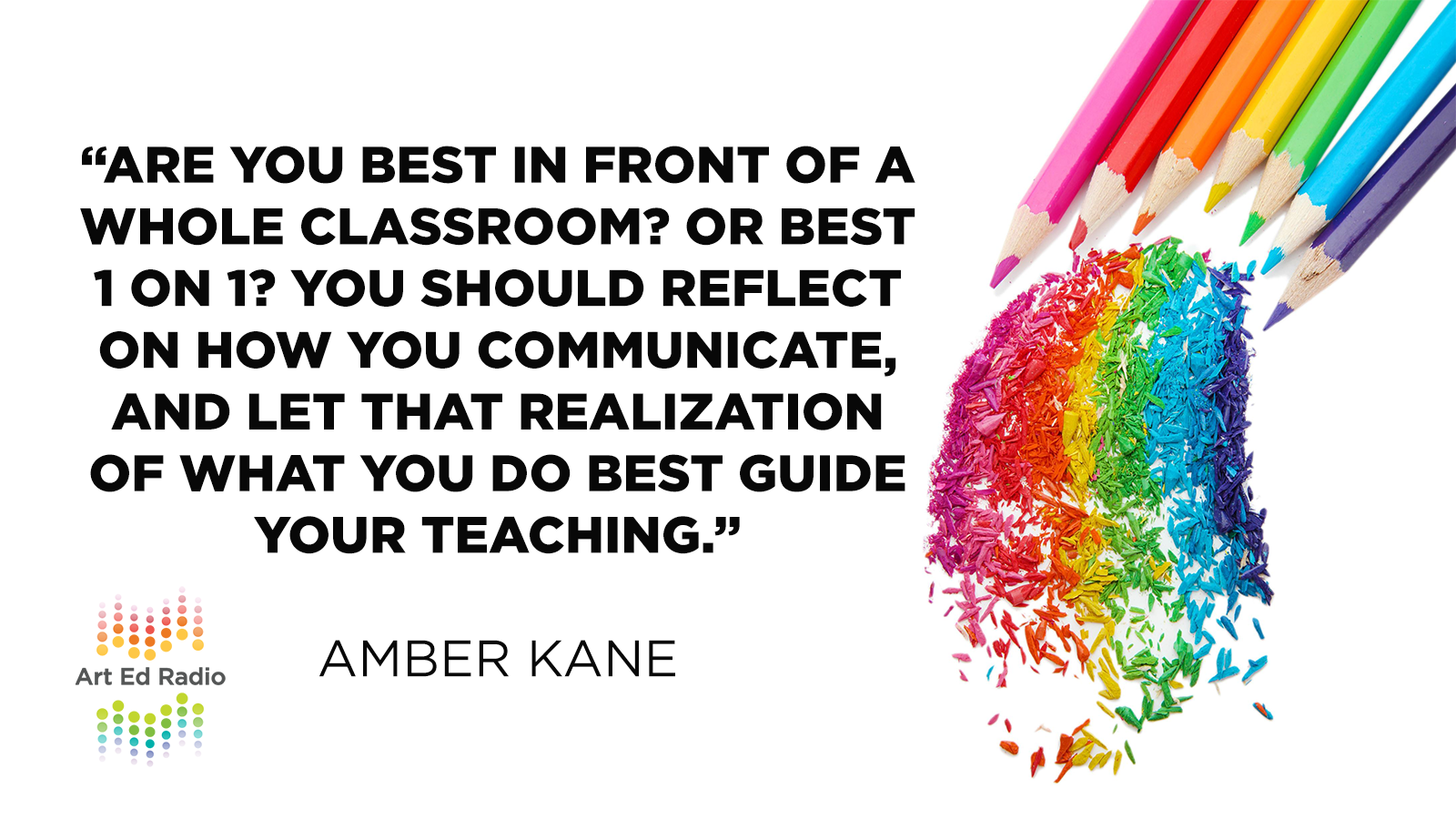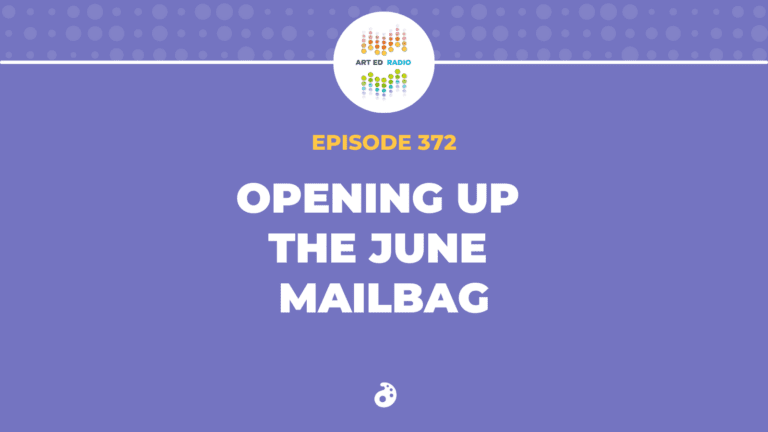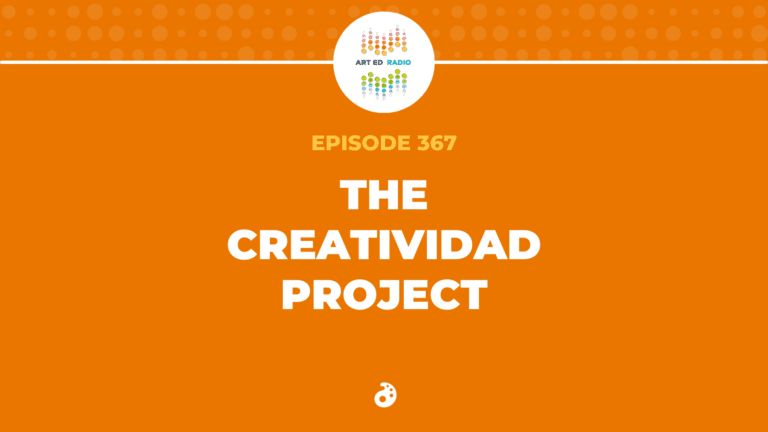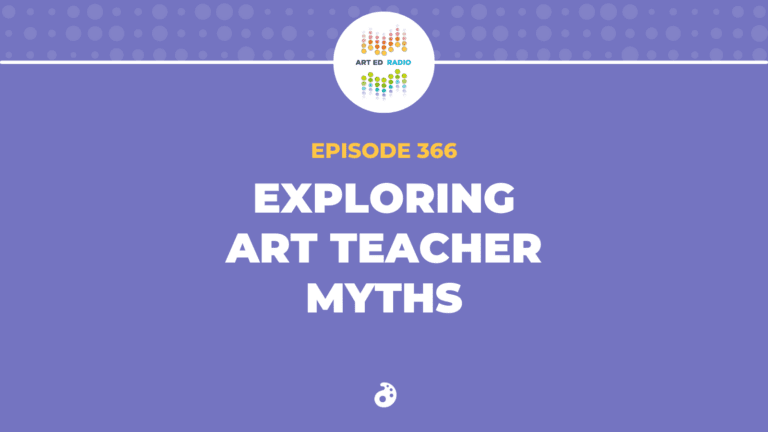One thing we don’t think about often enough, and rarely take the time to reflect on, is how we communicate. Today, AOEU’s Amber Kane talks to Tim about the importance of communication and how it can affect collaboration in our classrooms and our schools at large. Listen as they discuss what we need to ask ourselves about communication, how we play to our strengths, and how we take those strengths into our classrooms. Full episode transcript below.
Resources and Links
- Amber’s previous podcast appearance
- The case for more communication
- More ideas on collaboration
- Simple communication ideas with your students

Transcript
Tim: Welcome to Art Ed Radio, the podcast for art teachers. This show is teaching by The Art of Education University, and I’m your host, Tim Bogatz.
Today, we are going to talk about communication and collaboration. Now, the impetus for this topic I just want to explain a little to you. A couple of weeks ago, we talked about the AOEU Retreat, all of the great professional learning that was going on, a lot of things that we did. And one of those things was Amber Kane did a collaborative project with this extensive really colorful weaving project, but it also had these amazing exercises and lessons in communication, which made for a wonderful learning experience. When she posted pictures and when the AOEU account posted pictures, it just got this huge response on social media.
We started thinking that it might be a good podcast topic, so I invited Amber, or actually if we’re being honest, she invited herself, but she’s a good friend so we’ll let that slide. Hopefully, some of those lessons, some of those ideas, and some of those exercises that we talk about and converse about today can help you in both your career and in your classroom. Let me bring on Amber right now.
All right, and joining me now is Ms. Amber Kane. Amber, how are you?
Amber: I am doing wonderful. How are you?
Tim: I am doing great. I am very excited that you are on the show. I am very excited to talk to you, and I know you put together this awesome presentation at our team retreat, which I talked about a couple of weeks ago on the podcast. I know you’ve gotten a ton of attention for it on social media and kind of the awesome weaving you put together, but I don’t want to talk about that just yet because we need to learn our lessons first, right?
Before we actually got to do all this weaving at the retreat, you talked a lot about communication and learning how we best communicate. Let me just start with this question for you. Why do you think it’s important for us, especially as teachers, to reflect on how we communicate and the best ways that we communicate?
Amber: Yeah. I think for a lot of us, especially teachers, communication is something that tends to come rather naturally. We tend to like standing in front of a room and talking. Even written form of communication tends to be something that we do a lot. Whenever we do something a lot, we can also really easily fall into bad habits. If we don’t take the time to reflect on what we’re doing, what’s working really well, what’s not working at all, we really don’t have room to improve.
So as teachers, since we’re communicating so much and we’re communicating to our students, to our coworkers, to administrators and parents and all of those people need to be communicated with in slightly different ways, even using some different language. So every once in a while we sit back and reflect and come up with a plan and then implement that so that we just continue to get better as we move forward.
The other part of that is I’ve also realized it’s really easy to assume that everyone else really loves to communicate in the same method that you do.
Tim: Right, right.
Amber: For example, I hate talking on the phone. I lose my phone on a very regular basis, and it’s not normally on silent, so it’s hard to find. What I’ve realized is that that’s somewhat problematic because some of my coworkers, talking on the phone is their favorite thing to do and they can’t ever get ahold of me because I’m like, “I don’t know where my phone is located.”
I shouldn’t always be forcing them into my preferred method, which if it’s not face-to-face, then I really prefer a video chat. But I’m kind of realizing, well, that’s not always fair to push people into like, well, this is how I like it best and sometimes having to go back and forth.
Tim: Yeah, that makes a lot of sense. I want to actually dive into that in a little bit, but first, I want to ask you a little bit more if you can I guess expand on the idea of reflecting on how we communicate because that’s something I’m always doing on the podcast, is encouraging people to reflect usually on their teaching, but I think it’s valuable for communication as well.
In looking at theater, what kinds of questions, if people want to reflect, what should they be asking themselves? How can we, or I guess how should we think about how we’re communicating, and how do we go about reflecting on that?
Amber: Yeah. I’m going to pull out maybe the questions that I feel like especially when we did this at the retreat that people seemed to choose the most often and were talked about the most because that was kind of a signal to me that those seemed to be the most important and that people were really resonating with them.
One is to really think about, which I kind of alluded to in my last answer, is how do we prefer to be communicated to? Again, I wasn’t consciously realizing, well, I wish you would just do a co chat with me until I really sat down and started answering these questions of, oh, I like to have video conversations because I like to see people’s body language. Once you start to understand that, you can also tell people your preferred method of communication.
I think another really good one is looking at how do you best communicate? What is that platform for you? Are you best when you’re standing in front of a whole room of students? Are you best working in small groups, or working with one-on-one, or is your written communication really the strongest thing for you? When you realize what you’re best at, you can think about how can you do more of that, but it will also help you realize, well, maybe that’s not the thing I need to practice as much. I need to practice this other area that I’m not quite as strong in.
Then another, this is kind of a combination of a question to reflect on and a little bit of an exercise. So thinking about who are two to three people, and I think you could do this a couple different ways. You could break into groups. Even as teachers, you could think of coworkers, your students, and parents. Think of groups of people that you communicate with really well where it just comes naturally, and it sort of always has come naturally. Try and think about what are things that have actually made that work, and are there ways that you can actually implement that into relationships that aren’t going as smoothly?
And then also doing the reverse of who are two to three people that just communication never really seems to go smoothly? Like every time you try, you’re like, “I thought we were going to get it this time, and that was awkward again.” Really then start to think about what can you change, and then just start to try that of like, if every time you send a person an email, the communication is misunderstood and it turns into a mess, then maybe stop emailing and try to actually talk to the person in person or pick up the phone so that you’re a little bit more intentional and don’t just keep repeating the same disasters that you’ve had before.
Tim: Yeah, that makes a lot of sense. But I also want to ask you though, because you said to I guess share preferences with people around you on how you like to be communicated with, what would you recommend for people with that? Because doesn’t that seem like an awkward conversation to go your principal or go to your administrator and say, “Hey, when you talk to me, I’d like it to be in this format”? Because that’s going to be a super awkward conversation. So what would be your advice for how do you share that with people? How do you use that preferred method of communication, and hopefully get other people to do it as well?
Amber: Right, yes, because I guess we are trying to avoid those awkward conversations. Some is reflecting on first the group or the individual that you’re talking to. For me with my students, I’m actually very upfront and just tell them how I like to be communicated with.
While I did teach in the classroom for a while, I teach online now. So I repeatedly, because we all know we have to repeat ourselves, tell my students that my preferred method of communication is for them to ask questions within our Google Classroom. That’s easier for me to stay organized as well as it just lets all of the students see the question at once and hopefully makes it so I don’t have to answer the question so many times. And that they only email me if it’s something really personal or private.
As we all know, yes, that sounds great that I say that to them. And then you have to really continue to do that in practice. If a student emails me a question that is like, “When’s the assignment due?” That’s a question that should be in our Google Classroom. I will email them back and say, “You need to post this in Google Classroom to get an answer.” And I know that that can seem kind of tiresome in the beginning, and sometimes I do just want to answer the question and move on with my life, but that means they’re just going to keep on emailing. So some of it is that training.
I think we can apply that same type of idea with our administrators. So yes, depending on your relationship with your administrator, it would be weird to walk into their office and be like, “Look, I really hate face-to-face meetings, so from now on I’m going to need you to write me a handwritten letter because that’s what I prefer.” Some is helping to signal to them how you prefer to be communicated with so that maybe when they give you options for how you’re setting up a meeting, seeing if you can get it in writing.
Information for me in writing is actually one of my preferred methods, especially when there’s something I have to do. So when I had to have an in-person meeting with my administrator, I would actually go back to my room and kind of rewrite the action steps, like this is what we discussed has to happen, and send it an email. He was just kind of used to that, like, “I don’t need you to recap of like this is what Amber’s doing today.” So it was kind of meeting in the middle of this is where I need the communication to be, but I do know that it can’t always be me.
So thinking about how you can balance that out, and especially when you’re the one initiating the conversation, how do you initiate that conversation in your preferred method. And you might even say, “I’d appreciate you to write back with your response,” or if you send an email but your preferred mode of communication is in person, you might say, “And I’d like to set up 10 minutes to meet with you in your office,” or, “I’d like to set up a 15-minute phone call.” So trying to signal that.
And then also thinking about when you’re having your evaluations with your administrators, how can you incorporate that if it’s not going well, how can you incorporate that into your evaluation.
Tim: Okay. That’s all a lot of really good advice, so thank you for sharing all that and giving some direction to that conversation.
Now, I said earlier I want to talk about the weaving project as well because that was awesome, and you tied together both the communication aspect along with this collaborative project. It was beautiful. Visually it was incredible, and I know you got a ton of love on social media with it.
I guess basically can you just describe the project, how you tied everything together, and what you did with our AOEU team?
Amber: Yeah, sure. There were two goals with the project. The project was supposed to encourage communication, and also art-making. There were a couple different components to it. The first was what we’ve kind of already talked about, was me sharing some ideas about communication. Then on the table there were prompts of asking all different kinds of questions about communication. People could move around the room, and they were picking up paper strips, and they needed to respond to at least three of those questions. The goal of this was really to be more of a private personal experience, but to have everybody take some time to really reflect on different aspects of communication.
Then the next level of it was I gave very minimal instruction as to how the weaving should be done, and just stood back and watched. The only things that I encouraged were, because we had larger groups we had about 12 people in a group, was that people potentially broke into smaller groups and you could do smaller sections of weaving that then could be woven together because it was important to me that there weren’t some people just standing around with nothing to do, which most teachers are normally concerned about.
Tim: Yes, yes.
Amber: And also gave some instruction on there were glue sticks, that it can be helpful, but it wasn’t a requirement, that it could be helpful to just start to glue some ends down as they go to make the structure of the weaving a little bit stronger. Then I just kind of watched, and it was pretty fascinating because we also had three groups rotating through. The first group, they kind of started and could do whatever they wanted, and then the second group had to deal with what the first group left them.
Then I think probably my favorite part was the second group, they wrote a note to the third group because I had shared you’re welcome to attempt to communicate to the group coming after you. So they wrote them a note, and they asked if the piece could be wearable, because it had started to look like this crazy head piece.
The third group came, and I shared that note with them, and they adamantly were like, “No. This can not be wearable.” I was like, well, this is interesting. I’m just going to watch. How did they communicate that this is not wearable? They found a wooden frame that we were creating in. So they framed the weaving, and then they went and got a drill and they hung the weaving on the wall. So it was very clear communication: don’t you even try to wear this. Which even that is kind of interesting to watch and see how it all came together and how each group responded to the last group.
Tim: Yeah, that’s really cool. For those of you that haven’t seen it on social media, we’ll post in the show notes so you can kind of look back and see visually what we’re talking about here.
But Amber, I also wanted to ask you too just so this doesn’t stay just the AOE retreat stuff, is this something that you think people could do in their classroom? What would this exercise or what would this project look like if you were to do it with a group of students? How could people implement that?
Amber: Yeah, I think this would be so much fun to do with students. As I was really thinking about this, I probably would do it more as a beginning of the year activity, or near the beginning of the year because it’s one of those things that’s fairly easy so students are going to find success, which we know is important especially in the beginning of the year, and you can learn so much about your students while you’re watching them work as well as you already are kind of initiating that you want them to think about communication. You could also make up other questions if you wanted to, but you’re already getting them set in this idea of reflecting on different things, and then working together as a group.
As I mentioned, we actually had three groups of 12, and because there were different sessions going on, like each group came, worked for an hour, and then the next group came. If you wanted to, of course, you could actually model that by having one class after the other build on the piece and see what happens, but I also know some of you are, you know, that’s not possible because of your schedule. You’re moving to a different room for one class, and someone else is coming to use your room. So if you wanted to do it really just in one class period, part of the way that we did it is when you’re doing paper weaving, they don’t all have to be working on one weaving at a time. You don’t have to make a work, you just start to build it, and you can do the basic over-under weaving.
I had actually done this a lot at home, is you just start lots of mini weavings, leaving some of the ends loose, and then students can work on in groups starting to actually merge all of the weaving together. Which that in and of itself could be a really interesting lesson for your class so that they’re working kind of independently in smaller groups, but for the project to be finished, then the whole class has to come together and really think about how we actually connect this piece? What shape do we want it to make, and how do we work together to make it happen?
The other part to really think about, to go back to the idea of we never really love students to just be standing around, I also when I set this up made it people didn’t have to start with the writing part. It was just at some point during our activity time, they needed to write three responses, they needed to help with the weaving, and they needed to help with the gluing. They could use strips that were written on, or they could use just plain strips.
That way people always have something to be doing. They can kind of be rotating around, picking different jobs, and I think it’s just a really great way as a teacher to be able to move around the room, get to know your students, and just see how they interact with each other.
Tim: Yeah, that’s awesome. No, and I think that’s a really good description, and hopefully that gives people enough to go on if this is something they want to try.
Amber, we’ll go ahead and wrap it up there. Thank you so much for giving us some awesome advice professionally, and some great ideas for things we can do in the classroom. It’s been great, so thank you.
Amber: Yeah, thanks for hanging out with me.
Tim: All right. One part of that discussion that really stood out to me, and don’t get me wrong, it was all very, very good, but the one where Amber was talking about the exercise to figure out exactly what your strengths are with communication where you get together with two to three people, and when you communicate think about what goes well? What makes that type of communication work, and how do we implement those ideas or those practices in a little bit wider way?
Or, on the contrary, she talked about if things are going poorly, why is that, and what can you change? What can you do to make that better? I think all of those ideas are worth reflecting on and worth thinking about as you think about the bigger picture of communication, what works for you, how you communicate with your colleagues, your admin, your families, and your students. So put a little bit of thought into that.
And now also, somehow, we got through that whole interview without us talking about Amber’s incredible presentation at the Art Ed Now conference next week. Yeah, like all of a sudden, that is next Thursday. When I’m done here, I’m going to go keep working on some of those finals preparations, and when we are done here, you need to go register for the conference if you haven’t done that already. You can go to Artednow.com to register.
Amber’s presentation that I just mentioned is all about empowering your kids to make the most of their art class experience, and it’s some really, really good advice. I think that’ll be worth watching, and there’s also another 20 presentations that are definitely going to be worth your time, including the one and only Ron Clark, the founder of the Ron Clark Academy, and just a plethora of resources and ideas for the school year that’s frankly coming up a little sooner that we would like.
We will see you at the conference on July 25th, or if you can’t make it on that specific day, we will see you whenever you have time to access it throughout the next year because that is how long you have to get in on all the presentations and all the resources. It’s one day of learning, but you can continue to access everything and continue to learn for the next calendar year. It’s very much worth it.
Okay, that is all. Thank you to Amber for the discussion and the amazing ideas, and like I said, just great suggestions on how to improve your communication professionally with admins, with families, with colleagues, and also how to foster better communication in your classroom. It was all incredibly valuable.
Art Ed Radio is produced by the Art of Education University with audio engineering from Michael Crocker. Thank you so much for listening, and we will be back next week as we are getting ready for the Art Ed Now conference, and we will have a great preview for you. We’ll talk to you then.
Magazine articles and podcasts are opinions of professional education contributors and do not necessarily represent the position of the Art of Education University (AOEU) or its academic offerings. Contributors use terms in the way they are most often talked about in the scope of their educational experiences.



